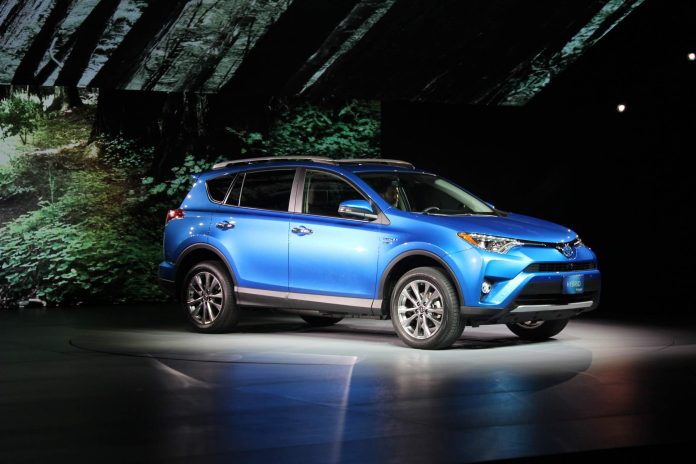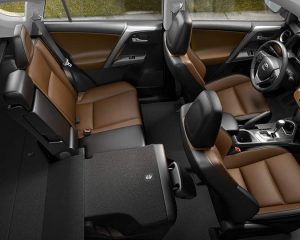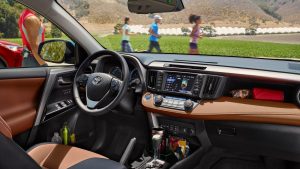It’s hard to make an economic case for any converted hybrid right now. This means all hybrids on the market right now, except for the Toyota Prius – which is the only hybrid built from the wheels up to be a hybrid.
What’s the difference? And why does it matter?
Converted hybrids began life as non-hybrids. Later on, their non-hybrid engine/drivetrain was replaced with a hybrid drivetrain. But the car wasn’t designed to be a hybrid – so it is invariably heavier and less efficient than a purpose built hybrid like the Prius, which was built around its hybrid drivetrain.
This is why a dedicated hybrid like the Prius averages 50 MPG but converted hybrids like the RAV4 hybrid that’s the subject of this review average much less – and not much more than the non-hybrid version of the same thing:
34 city, 30 in the highway – vs. 23 city, 30 on the highway.
Which is a big problem when gas is cheap – and the hybrid conversion costs several thousand dollars more to buy than the non-hybrid version of the same thing.
WHAT IT IS
The RAV4 hybrid is a gas-electric version of Toyota’s compact-sized crossover SUV. It’s similar in general layout to other models in this segment such as the Honda CR-V, Ford Escape, Hyundai Sante Fe Sport and VW Tiguan, among others – but unusual in terms of being a hybrid.
Because none of those others offer a hybrid configuration.
Subaru used to – the hybrid version of the Crosstrek – but it’s been cancelled.
They may have been on to something.
The RAV4 hybrid isn’t a bad vehicle – because the RAV4 is a very good vehicle. It’s one of Toyota’s best-sellers, in fact. The problem – for the hybrid – is justifying its $2,725 higher MSRP ($27,135 to start) vs. the non-hybrid RAV.
One way Toyota hopes to do that is by making all-wheel-drive standard in the hybrid. It’s optional in the non-hybrid RAV. This closes the price gap significantly. While the front-wheel-drive non-hybrid RAV costs $24,410, the AWD-equipped version starts at $25,810.
Thus, the difference in price between the AWD hybrid and AWD non-hybrid is only $1,325 – which makes the hybrid’s math more favorable.
It will still take some time – and some miles – to work off that $1,325 in fuel savings. But it won’t take nearly as long as it would to work off the almost $2,800 difference between the FWD non-hybrid RAV and the AWD hybrid RAV.
Maybe less . . . if gas prices go up.
WHAT’S NEW
Another – subtler – way that Toyota has come up with to make the hybrid RAV more economically persuasive is by offering it in a lower-cost LE trim, just like the non-hybrid RAV.
Last year, the RAV hybrid was only available in higher-line XLE, SE and Limited trims – each progressively more expensive. The least expensive being the $29,030 XLE. That widened the price gap between the hybrid and the non-hybrid to more than $4,600 – an economically unsupportable proposition when gas is about $2.25 per gallon.
The XLE and Limited trims did (and still do) come with additional amenities such as leather trim, a two-tone interior, heated seats and navigation. Such amenities are certainly nice – but if you’re trying to save money – the main justification for buying a hybrid, right? – they run counter to the object of the exercise.
Besides which, the LE – hybrid or not – isn’t a stripper. It comes with most power options, heated outside mirrors, a 6.1 inch LCD touchscreen, six-speaker stereo and climate control AC, among the highlights.
And – if you buy the hybrid – standard AWD.
The hybrid RAV is also quicker than the non-hybrid RAV
Lowered price – and standard AWD – makes it a more economically viable proposition.
Speedier than the non-hybrid RAV.
Can go about 150 miles farther in “city” driving than the non-hybrid RAV (503.2 miles vs. 365 miles, according to the EPA).
Same generous first and second row legroom as the non-hybrid RAV.
WHAT’S NOT SO GOOD
Still more expensive to buy vs. otherwise-the-same non-hybrid/AWD-equipped RAV.
The $1,325 extra you pay for the hybrid vs. the non-hybrid equivalent RAV (with AWD) buys about 576 gallons of gas at today’s current $2.30 (give or take) per gallon. Assuming an average of 25 miles per gallon, that amount of gas would keep the non-hybrid RAV rolling for a long time before the hybrid RAV’s higher MPGs begin to save you money.
Heavier than the non-hybrid, is one of the reasons why the gas mileage isn’t so great.
Both the hybrid and non-hybrid RAV have 2.5 liter four cylinder engines under their hoods – but the hybrid’s is supplemented by three electric motors and a battery pack. These combine to boost the total output of the system from the non-hybrid’s 176 hp to 194 hp.
A continuously variable (CVT) automatic is standard.
The set-up is similar to the one used in the Lexus RX hybrid – a much pricier hybrid. One of the electric motors helps turn the front wheels; the second serves as a combo starter motor (for the gas engine) and generator for the nickel metal-hydride battery pack.
The third powers the rear wheels.
The system differs greatly from the non-hybrid RAV’s optional all-wheel-drive system, which kicks power made by the 2.5 liter gas engine to the rear wheels on demand, when slip is sensed up front – through a center differential. In the hybrid, the rear wheels are powered independently of the engine up front.
One advantage of this is better weight balance, because the hybrid RAV has the weight of the rear motor (and the battery pack) toward the rear of the RAV while the non-hybrid has most of the weight up front.
One disadvantage is the hybrid’s higher curb weight as a result of the extra gear: 3,950 lbs. vs. 3,455 for the non-hybrid RAV. This probably accounts for the hybrid’s only so-so mileage vs. the non-hybrid: 34 city and 30 on the highway vs. 23 city, 30 on the highway.
Note that the hybrid’s highway mileage is exactly the same as the non-hybrid’s – and not spectacular. This is almost always the case with hybrids, which are optimized for low speed, stop-and-go driving – which allows minimum use of the gas-burning engine.
On the highway, the gas engine is almost aways running – and because the hybrid is heavier, it is running harder. This is why most hybrids – including even the Prius – get worse mileage on the highway than they do in city driving, which is the opposite of non-hybrid cars.
Converted hybrids like the RAV hybrid suffer even more on the highway, because they are usually heavier than their non-hybrid counterparts.
This is why there’s only an 11 MPG difference – best case – between the hybrid RAV and the not. The Prius – which gets 50 MPG, worst case, on the highway – is easily 15-20 MPG easier on gas than any gas-engine-only/otherwise-equivalent small sedan. Because it’s been designed from the wheels up to be maximally efficient and in particular, light weight.
The main hybrid RAV upside, as it turns out, is performance.
It’ll get to 60 in about 7.8 seconds, which is speedy for the class – and much speedier than the non-hybrid RAV, despite it being so much lighter.
The non-hybrid RAV takes close to 9 seconds to achieve 60 MPH.
It’s ironic in no small way that the hybrid RAV is the speediest RAV. This is so because the non-hybrid RAV is under-engined. Even though it weighs hundreds of pounds less than the hybrid, 3,455 lbs. – that’s empty, before any people get in – that is still a lot of sheetmetal beef for 2.5 liters to deal with.
At least, without a turbocharger.
Or an assist from electric motors and batteries.
While the horsepower difference is not huge – just 18 of them separate the hybrid from the non – the torque difference is.
And not just the numbers. Electric motors produce peak torque immediately. Apply this to the wheels – front and rear, immediately – and the result is a two second faster sprint to 60 and much quicker acceleration whenever acceleration is called for.
Think about two 650 Volt motors twisting those axles – plus the output of the 2.5 liter gas engine. Toyota has reversed the usual Hybrid Dynamic, which is that the non-hybrid version is quicker, while the hybrid is slower. So what you get here is a more responsive RAV, despite it being heavier.
But it’s a shame about the mileage. See that part about the weight.
You’ll notice that in the curves, too – if you push the thing. Most probably won’t. Which means the additional several hundred pounds will be invisible to them. It might even be a benefit to them – in that the extra weight anchors the hybrid RAV to the pavement better, which is a good thing given this crossover’s tall profile and 7 inches of ground clearance. Laterally, that weight heaving to the outside of the curve’s not the hot ticket – and if you jerk the steering wheel abruptly to avoid something in your path, you’ll also feel it sloshing around.
But on the highway, pointed in a straight line, it makes the hybrid feel more solid – more planted.
And in the city, the hybrid is really quiet.
Like others of its species, it can trundle around on battery power alone – not super far and not very fast – but in the stop-and-go, it can do so almost continuously or at least as long as the batteries hold enough charge.
This thing would be vastly more capable as a hybrid if it had plug-in capability, as the Prius offers. That would include higher-capacity batteries and the ability to juice up the batteries without resorting to the gas engine.
Aber, the problem with that is cost. The plug-in gear gooses the MSRP by several thousand more – making the economic case even less tenable.
Compact crossovers like the RAV are popular in part because they are space efficient. The RAV is about the same overall length (183.5 inches) as a compact-sized sedan like the Toyota Corolla (183.1 inches) but the tall/crossover SUV roofline provides vertical space that almost triples the RAV’s cargo space to 35.6 cubic feet behind its second vs. 13 cubic feet in the Corolla.
And that’s without folding the RAV’s second row flat. Do that and the total cargo space opens up to 70.6 cubic feet.
The Corolla does have a few inches more backseat legroom – 41.3 inches vs. 37.2 in the RAV – but neither are cramped and the Corolla doesn’t offer the additional versatility of AWD. It’s front-drive only, and low to the ground (vs. the RAV) which makes it not the ticket for snow days, while the RAV of course, is.
You also get more headroom – in both rows – because of the taller roofline. And you sit up higher, which is something people seem to really like about crossovers generally.
The hybrid RAV has most of the same desirable attributes. There is a bit less cargo space than in the non-hybrid (38.4 cubic feet of cargo capacity behind its second row; 73.4 cubes with the second row folded) but otherwise it’s the same – except that the AWD is standard.
The instrument cluster is specific to the hybrid RAV, with a “charge/power” gauge to the left of the speedometer – and in place of a tachometer. And as in the Prius and other Toyota hybrid vehicles, you can toggle a “hybrid” display through the LCD touchscreen in the center stack that shows in real-time what the hybrid drivetrain is doing and also how you’re doing, in terms of fuel/energy consumption.
Unlike the Prius – which goes all-out to let you know it is a hybrid – other than the slightly different instrument cluster and the additional, hybrid-specific menus viewable through the standard 6.1 inch touchscreen – the hybrid RAV’s interior, like the rest of it, is nearly identical to the regular RAV’s. It even has a “normal” console-mounted, grab-handle gear selector – not a toggle-style lever, as in the Prius.
Some worthy design features, in terms of these being functionally excellent, are the extra-large air vents (two of these are ball-type, and can be rotated in almost any direction) and the not-small rotary knobs you use to adjust the AC and heat. Also the plainly visible/accessible USB/power points, which are not hidden in the center console but rather mounted forward of the shifter, at the bottom of the center stack.
There is also an additional storage cubby above the glovebox on the passenger’s side. And there is still a manual pull-it-up emergency brake lever – no “eBrake.”
You also get adaptive cruise control – which is handy – but it’s bundled with Toyota’s pedestrian detection and automated braking systems (as well as lane keep assist). These are, frankly, idiot-proofing system which non-idiots can easily live without. They sometimes “jump in” pre-emptively, hassling you with warning lights – and automatic intervention – when it’s not necessary or not necessary right this second.
It’s too bad these systems – which add both cost and complexity – can’t be left on the options list for those who want them and want to pay extra for them. Meanwhile, those who don’t could have the option to save a couple hundred bucks on the car.
Which would make the economic case for it even stronger.
Hybrids make a lot more economic and functional sense than electric cars – which are being pushed aggressively, despite their high cost and significant functional impairments.
Unlike an electric car, a hybrid is not dependent on an electrical outlet. There is no range anxiety. It can go farther – usually – than a non-hybrid equivalent. And it doesn’t take any longer to refuel.
But – while gas is cheap – it it still hard to make the economic case for buying one vs. the same thing in non-hybrid form.
If you live in the city and most of your driving is below 40 MPH and often stop-and-go, then the hybrid RAV absolutely could save you money overall, because you’ll be motorvating on the batteries (and motors) a large part of the time, which means you’ll be getting fuel economy numbers closer to the “city” number – 34 MPG.
Maybe more.
But if you’re often out on the open road where the traffic is running 70-plus and you have to keep up with it, your mileage will likely be disappointing – and it will be a longer time before you reach Break Even vs. the non-hybrid which – don’t forget – gets the same 30 MPG on the highway as the hybrid.
Maybe less.
THE BOTTOM LINE
You do get more speed – and that’s certainly worth something, too!
. . .
Got a question about cars – or anything else? Click on the “ask Eric” link and send ’em in!
If you like what you’ve found here, please consider supporting EPautos.
We depend on you to keep the wheels turning!
Our donate button is here.
If you prefer not to use PayPal, our mailing address is:
EPautos
721 Hummingbird Lane SE
Copper Hill, VA 24079
PS: EPautos magnets – they’re back! are free to those who send in $20 or more to support the site. Also, the eBook – free! – is available. Click here. Just enter you email in the box on the top of the main page and we’ll email you a copy instantly!


















Well, I’d go with the hybrid. Most of the differences, either pro or con, are not significant.
What’s indisputable is that you get significantly better performance with no fuel economy penalty. Transforms this car from being just another totally boring CUV, into one that’s slightly interesting. And noticeably more fun to drive.
Not your fault by any means, but looking at the list of your recent new car reviews reveals a majority of fairly boring vehicles. Most new models are boring. Hope you soon can get something like a Kia Stinger to review. 🙂
Hi Mike,
Yup, agreed!
And – should be getting some interesting stuff soon. The problem – as you’ve noted – is the profusion of appliances, especially crossovers. Cue the little ditty from Weeds about how they all look just the same….
Toyota doesn’t offer leather seating in this vehicle – it’s faux leather. With the introduction of the 2013 model RAV4 the cheapening began, and continues. The 2012 RAV4 V6 4WD model was an excellent vehicle, nothing like it available today.
RAV4 Features dropped for 2013:
V6 Engine option, 3rd row option, Full size spare tire, Optitron gauges, Headlamps “ON” indicator,
Valet key on some models, LED tail lights & brake lights, Auto OFF headlights (except Limited), Variable intermittent wipers on LE, Seat fold-down levers in cargo area, Sliding adjustable 2nd row seats, Door sill protectors, 12v Power outlet in cargo area, Large under floor storage compartment, Sunglasses storage bin, Sun visor extensions (except Limited), Dual-level center console storage, Locking glove box, Upper glove box with door, Footwell lighting (Limited), 110V AC power outlet (Limited), Real Leather seating, Cross bars on roof rack, Hill Assist Control (HAC), Downhill Assist Control (DAC), Longer tonneau cover with headrest clips, Fender flares on Sport and Limited, Body colored front and rear bumpers, XM Satellite radio (except with Navigation), Auto Up/Down driver’s power window on LE.
Hi Liberty,
Yup; sad about the V6 – Uncle, again.
Saw the tsunami (uncle) coming and acquired two 2012 V6 4WD RAV4s. 0-60mph 6.4sec, 1/4mile 14.9.sec. Another owner, with alleged just intake modifications, is doing the quarter in 13.8. No problem with traction – automatically always in 4WD at 25mph and below.
Good for Him usually the CAI is just a wallet lightner and with a low restriction filter element, those elements let in a fair amount of crude.
The point I would like to make about the so-called “Cold air intakes” is the fact the manufacturers would be using them if they offered that much of a benefit.I got one for My Dodge Dakota ( didnt notice a thing except for over a Hundred dollar lighter billfold,I finally threw the foam filter element away and used the stock paper filter , noticed no decrease in performance,The supposedly stainless steel “super Turbo” muffler fell off after a couple of years and reinstalled the stock muffler again the “Butt Dyno” noticed no difference.
This not to say some of these things probably do offer some benefit, as usual, “Caveat Emptor” the one thing I could have done for the same money that would have offered a little increase on the Dodge, would have been to install an “E-Fan”,Dodge did everything they could to cheapen this vehicle and by my past experience I will probably never have another “Dodge truck”( a single return spring on the rear drums, really ?) Another feature that is not too endearing on this vehicle is its cold weather gas mileage( it seems to take a gallon to start it up) due to its high weight it has very little performance either. Other than its faults its pretty good little truck.
“Assuming an average of 25 miles per gallon, that amount of gas would keep the non-hybrid RAV rolling for about 15,000 miles before the hybrid RAV’s higher MPGs begin to save you money.”
Well, no. Assume you drive 100,000 miles. Absolute best case scenario — you never ever drive outside a city. Hybrid’s 34 MPG means about 2940 gallons of gas used. Non-hybrid’s 23 MPG means about 4350 gallons of gas. Savings? 1410 gallons of gas. At $2.30 a gallon, that’s about $3,240 in savings over 100,000 miles of all city driving. So, to save just $1,325 — about 40,000 miles of driving to get to break even.
Worst case scenario — all highway driving — $0 in savings over 100,000 miles. So, you’d have to drive infinity miles to recoup the costs.
50/50 split city / highway means 26.5 MPG versus 32 MPG, which pencils out to roughly 90,000 miles.
“It will still take some time – and some miles – to work off that $1,325 in fuel savings”
About 90,000 miles at current gas prices.
If you actually want AWD — and do about 50/50 city versus highway driving — and you don’t have a whopping bill come due to replace all those batteries.
Really, the hybrid upgrade only makes economic sense if you do almost all city driving and live somewhere cold where AWD would help in the snow.
Probably not very expensive to replace a hybrid’s (non plug-in) battery – they’re not very big.
Here (absolutely not a “green” state) I can have a remanufactued battery for an older Prius (2nd/3rd generation) installed at my home or work for $1500.
Infiniti announces ‘it will go electric’ starting in 2021, but what does it mean?
https://electrek.co/2018/01/17/infiniti-go-electric-2021/
They have no choice.
As Eric has pointed out over and over again, the coming CAFE fatwas are not possible to be complied with here in the US.
And with so many countries (and possibly Kalifornia) banning ICE vehicles in the near future, if these outfits want to stay in business, they will comply with what government demands.
What WE want and demand, as drivers and customers, well, we can all go get fucked.
Sounds like GM thinks electric cars won’t be getting any cheaper anytime soon.
http://gmauthority.com/blog/2018/01/majority-of-gms-forthcoming-electric-cars-will-be-cadillacs/
If they think they can go all electric with Cadillac, the brand is a goner.